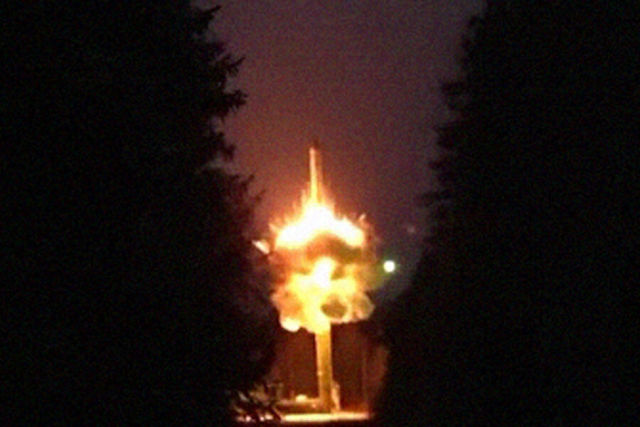Colonel Khodarenok called the training of the Russian nuclear forces an unambiguous message
The Russian Armed Forces conducted a strategic command and staff training on the combat use of strategic nuclear forces. What kind of training it was, why it was conducted and whether such exercises could be considered something exceptional, the military observer of the Newspaper understood.En" Mikhail Khodarenok.
What happened?
During the strategic command and staff training (SKSHT), an intercontinental ballistic missile of the RS-24 Yars mobile ground-based missile system (PGRK) was launched from one of the sites of the 1st State Test Cosmodrome of the Ministry of Defense of the Russian Federation (Arkhangelsk Region, Mirny) at the Kura test site in Kamchatka.
In the waters of the Barents Sea, a ballistic missile of the submarines R-29RMU2 "Sineva" was launched from the missile submarine of the strategic purpose (PKK SN) project 667BDRM K-114 "Tula".
Two Tu-95MS strategic bombers of the Long-range aviation of the VKS of the Armed Forces of the Russian Federation took part in the SKSHT, which launched strategic air-launched cruise missiles of the X-55CM type.
It should be emphasized that in the course of this SKSHT, the Armed Forces practiced not a preemptive, not a preventive, but a counter-strike. That is, Russia does not threaten anyone with its nuclear weapons, but only demonstrates its readiness to repel a possible massive nuclear missile strike by a potential enemy.
How many forces were involved?
At first glance, not so much effort and funds were attracted to the training. But this impression is very deceptive, and in such a case, figuratively speaking, only the tip of the iceberg is visible.
For example, if a retaliatory strike is being worked out, then first the missile attack warning system (SPRN) generates a "Missile attack" signal for the country's top leadership.
After receiving such a signal, the Supreme Commander-in-Chief of the Armed Forces of the Russian Federation, the President of Russia decides to launch a massive missile and nuclear retaliatory strike, gives permission for the use of nuclear weapons, as well as a command to unlock nuclear combat units. All these signals and commands along the corresponding chain must reach specific performers, up to the head of the calculation, in other words, each individual carrier. And all this is checked and carefully worked out to automatism in the course of such SKShT.
As for the allegedly insufficient number of forces and means involved, we will consider this issue only on the example of the Northern Fleet. At first glance, of the naval strategic nuclear forces in the SF, only one missile submarine "Tula" was involved in the training.
In fact, almost the entire fleet takes part in such exercises - the minesweeping forces of the SF ensure the launch of the missile carrier into the combat service area; in order to ensure the combat stability of the Strategic Nuclear Forces, naval strike groups and anti-submarine forces of the fleet are deployed; the Barents Sea is patrolled by naval aviation. And one strategic missile submarine has entered combat service, which means that, if necessary, all other SF missile carriers will also come out.
All this applies equally to the rest of the Armed Forces and branches of the Armed Forces.
What kind of ammunition is used?
During the training launches of intercontinental ballistic missiles (ICBMs) and submarine-launched ballistic missiles (SLBMs), inert warheads are used instead of regular combat units. Throughout their flight, ICBMs and SLBMs are accompanied by control and measurement complexes, separate radio-technical nodes of the missile attack warning system, and the necessary trajectory measurements are continuously carried out.
As a rule, one rocket from a particular batch produced by the manufacturer is used for such launches. One product has been successfully launched, which means that, if necessary, the whole batch will fly.
Due to the ICST, a number of Arctic regions are closed to the movement of civilian vessels from October 22 to 28. Given that the Novaya Zemlya archipelago also fell into the area of restrictions, it cannot be excluded that the final tests of the newest strategic cruise missile with a nuclear engine "Burevestnik" are planned.
How unique are these teachings?
The United States is also following such launches very closely. With the help of its very advanced Nuclear missile strike Warning System (SPRYAU) The United States carefully records all possible flight parameters of our ICBMs and SLBMs in this case.
To the question whether such a SKSHT is a unique phenomenon in the operational training of the Armed Forces of the Russian Federation or is a common phenomenon in a number of such events, it should most likely be answered as follows - for the functionaries of combat crews, this is certainly routine. But in our very difficult times, in general, such a SCT is definitely an unambiguous message to our hypothetical opponents - Russia keeps its nuclear powder dry and is ready for any surprises.
The opinion of the author may not coincide with the position of the editorial board.
Biography of the author:
Mikhail Mikhailovich Khodarenok is a military columnist for the newspaper.Ru", retired colonel.
He graduated from the Minsk Higher Engineering Anti-Aircraft Missile School (1976), the Military Air Defense Command Academy (1986).
Commander of the S-75 anti-aircraft missile division (1980-1983).
Deputy Commander of the anti-aircraft missile regiment (1986-1988).
Senior Officer of the General Staff of the Air Defense Forces (1988-1992).
Officer of the Main Operational Directorate of the General Staff (1992-2000).
Graduated from the Military Academy of the General Staff of the Armed Forces of Russia (1998).
Columnist of "Nezavisimaya Gazeta" (2000-2003), editor-in-chief of the newspaper "Military-Industrial Courier" (2010-2015).
Mikhail Khodarenok

